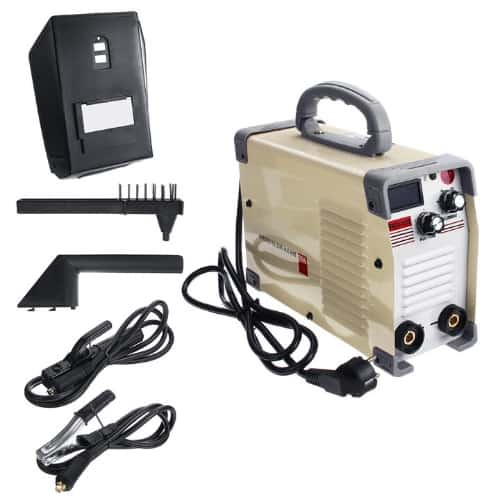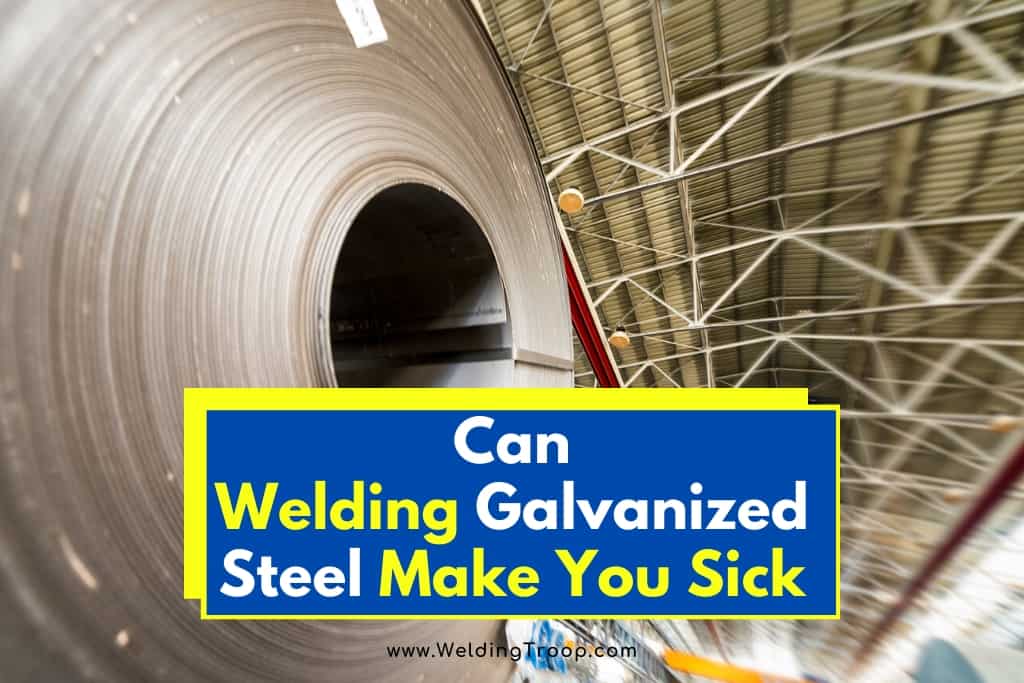Welding galvanized steel is not a pleasant experience, but can it make you sick? When you weld galvanized steel, it’s crucial to prep the metal and use protective equipment.
Can welding galvanized steel make you sick? If inhaled, the fumes from welding galvanized steel can cause galvanize poisoning. The symptoms of galvanize poisoning include chills, shakes, nausea, fatigue, vomiting, and fever.
Few welders can work with a single metal throughout their careers. Welding requires you to learn how metals with different melting points react to the welding process. The size, thickness, and density of a metal help you determine which welding process is most effective. However, coated metals, such as galvanized steel, make the decision more complicated.
The coating protects the metal from corrosion, but it also seems to protect the metal from welding. If you fail to remove the zinc coating, the metal violently reacts to an electric arc and produces noxious fumes. When you weld galvanized steel, it’s essential to wear protective gear and use the proper techniques to stay safe.
Table of Contents
How Can Welding Galvanized Steel Make You Sick?
The zinc coating that covers the surface of galvanized steel converts to zinc oxide when a welding arc heats the metal. Zinc oxide is a toxic substance that can cause galvanize poisoning, which is also known as metal fume fever.
Metal fume fever is an avoidable condition that may be caused by the following factors.
- Working in a cramped space
- Poor ventilation
- Wearing goggles instead of a helmet
- Poor posture
Related Reading: Why Is Welding Galvanized Steel Dangerous?
Working in a Cramped Space
Sometimes a welding repair job requires you to work in a cramped area. This is not a rare occurrence for welders, but some welder’s fail to take extra precautions when the workspace is cramped.
The toxic fumes from welding galvanized steel are hard to avoid when you’re unable to vent the fumes away from your workspace. If you’re unable to use a fume extractor or hood system to absorb the fumes, wear a respirator to protect yourself.
Ensure that your respirator is reusable and includes changeable filters. You may have to look around to discover a respirator that offers adequate protection from fumes and fits under your welder’s helmet. Premium respirators are rated for mining and welding operations and offer the highest level of protection from toxic fumes.
Poor Ventilation
Working in a large open space is more ideal than welding in a cramped one, but without proper ventilation, you risk inhaling the toxic fumes. If most of your work involving galvanized steel occurs in a welding shop, try working with fume extractors or hood systems to avoid fumes.
Welding shops that fail to provide employees with adequate ventilation may violate OSHA guidelines. If your supervisor is unwilling to provide the necessary ventilation, your last resort is to contact OSHA.
Although you may be hesitant to report managers to a regulating agency, your health should be your primary concern. Welder’s should not frequently become sick at work when proper ventilation is provided.
Related Reading: Respirators for Welding Galvanized Steel | Welding Hazards Respiratory Protection
Wearing Goggles Instead of a Helmet
Premium helmets that cover a welder’s neck and head offer the most effective protection against fumes. Welders who favor wearing goggles should switch over to a helmet when working with galvanized steel.
Goggles protect your eyes from glare and spatter but cannot protect you from toxic fumes. If you frequently work with galvanized steel, wear a quality helmet.
Poor Posture
Your welding stance can influence the level of toxic fumes you inhale. Although welders must work close to the workpiece to perform effective welds, if you’re too close, you cannot escape the fumes.
It’s challenging to change a stance that you’ve become accustomed to, but moving your head back a few inches can protect you from inhaling zinc oxide.
How Do You Avoid the Effects of Metal Fume Fever?
If you have to weld galvanized steel, there are a few steps you can take to protect yourself from contaminates.
- Work in a ventilated area
- Wear protective gear
- Grind and clean the metal
Work in a Ventilated Area
On welding forums, welders that experience metal fume fever often complain about the poor ventilation at their worksite. If you search through blog posts and welding sites, you would be surprised how often welders are sickened by galvanized steel.
Although it is a frequent occurrence among welders of all skill levels, metal fume fever is an avoidable condition. Welding outside is the ideal location for welding galvanized steel, but if you are unable to bring your work outdoors, ensure that your worksite has adequate ventilation.
Set up fume extractors next to your work area to vent away the toxic fumes. Place the extractors two feet away from the welding area to provide optimal ventilation. If your shop has a hood system, you should position your workspace directly under the hood vents.
Related Reading: Can You Arc Weld Outside? | Understanding welding Outdoors
Wear Protective Gear
Although it may seem uncomfortable in hot environments, protective gear can guard you against the effects or galvanize poisoning. Purchase a premium respirator and a helmet that covers the respirator.
Using a painter’s mask or medical mask will not protect you from the find particulates emitted from zinc oxide. Only use a mask designed with carbon filters that are approved for welding and mining operations. Read the product specifications included with the respirator to find out if it is OSHA approved.
Although there is no evidence suggesting metal fume fever causes permanent damage, the symptoms of the condition resemble the flu and may take two days for a complete recovery.
Rather than risk your health and lose hours on your paycheck, you should always use protective gear to minimize your exposure to zinc oxide.

Grind and Clean the Metal
If you remove the zinc coating on galvanized steel, you will minimize the zinc oxide fumes. Before welding, use a grinder to remove the coating. Manufacturers use two methods to produce galvanized steel, and the hot-dipped process offers superior rust protection but is more challenging to weld.
If the galvanized steel is produced by the spray-on method, the zinc coating is less dense and is easier to remove. Whichever type of galvanized steel you encounter, remove the layer of zinc surrounding the welding zone.
A grinder is the best tool for removing the layer, but coarse sandpaper is a suitable alternative. After you grind away the coating, wipe down the workpiece with a dry cloth. Zinc filings will interfere with your weld pool and result in zinc oxide fumes when ignited.
Which Welder Should You Use on Galvanized Steel?
An arc welder is the ideal machine for welding galvanized steel. The flux coated electrode from an arc welder protects your weld pool from zinc oxide and offers superior penetration when compared to other welders.
Another advantage of using a stick welder on galvanized steel is the ability to work in windy conditions. Unlike MIG welding, an arc welder does not require you to use a shielding gas.

Wind will blow away the protective gas and result in erratic weld pools. You can use an arc welder on galvanized steel as long as the wind speed is less than 35 mph.
MIG wire will not produce effective welds on galvanized steel, but if you do not have access to an arc welder, you can recalibrate your MIG welder to accept flux core wire. Flux core welding does not use shielding gas but relies on the flux coating to protect the weld pool.
Remember to change your machine’s polarity before you use the flux core. Before welding, follow the correct safety procedures and grind off the zinc coating.
Related Reading: Is it Safe to Weld in the Wind? Maximum Wind Velocity
Closing Remarks
All metals produce fumes that you should avoid, but galvanized steel is particularly hazardous to weld.
Protecting yourself from the toxic fumes of zinc oxide is essential if you want to stay healthy and productive.
As long as you have protective equipment and work in a ventilated area, metal fume fever will not affect your health or your paycheck.
Recommended Reading
Respirators for Welding Galvanized Steel | Welding Hazards Respiratory Protection

